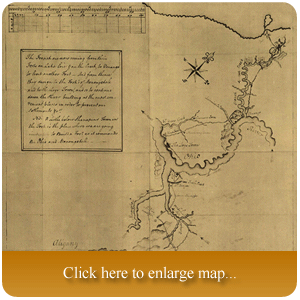A Focal Point in Early American History
Washington’s party traveled up the Allegheny to its confluence with French Creek at Venango, where he was told that he must speak to officers located further upstream at Fort LeBoeuf. On his way to that destination, he spent the night of December 8th, 1753, at present-day Terrace Street in Meadville. At Fort LeBoeuf, Washington conferred with French commander Captain Jacques Legardeur de Saint-Pierre. He was treated with deference, but received no reply to Dinwiddie’s request for French removal. On the perilous return trip, Washington survived capsizing in the icy waters of both French Creek and the Allegheny River, and an assassination attempt.
His journal of the adventure underscores the hazards of winter travel along French Creek, and is rife with references of landmarks throughout the watershed. In a map of the mission he applied the term “French Creek” for the Riviere aux Boeuf, helping to secure its modern name. Just six months after his journey Washington led a party that ambushed French troops in a skirmish known as the Battle of Jumonville Glen, the first “official” engagement of the French and Indian War that eventually ended French claims to the Ohio Territory.
American settlement of the French Creek Watershed began after the cessation of land by Native Americans at the Second Treaty of Fort Stanwix in 1784. In 1800, there were approximately 2,500 settlers in Crawford County. Ten years later there were approximately 6,000, and by 1830 there were 16,000. The fertile soil of the French Creek Valley made it among the most prized farmland in northwestern Pennsylvania.



